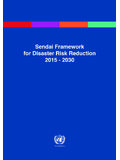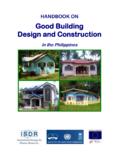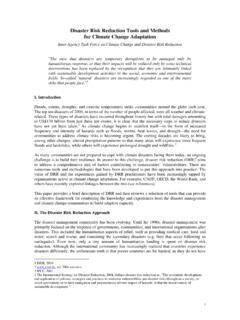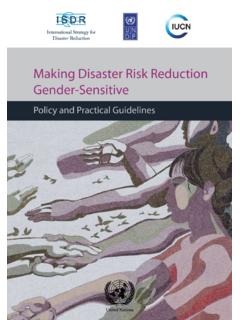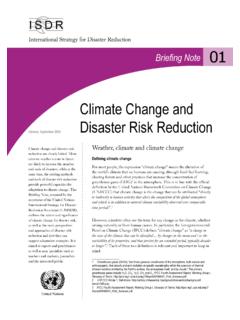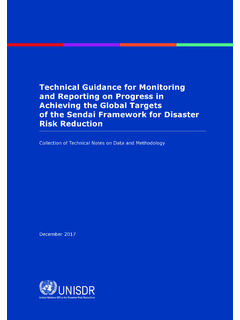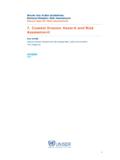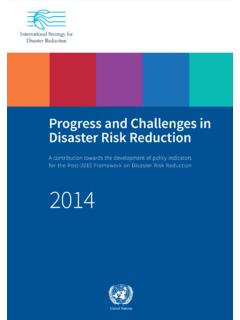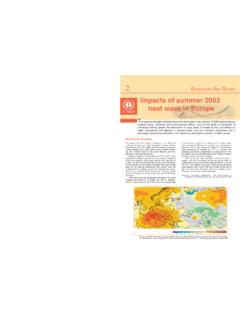Transcription of COMMUNITY-BASED DISASTER RISK MANAGEMENT FOR …
1 COMMUNITY-BASED DISASTER RISK MANAGEMENT FOR LOCAL AUTHORITIESPARTICIPANT S WORKBOOKA sian DISASTER Preparedness CenterThe Partnerships for DISASTER Reduction - South East Asia Phase 3 (PDRSEA3) program is jointly implemented by (ADPC) and the UNESCAP with funding support from the European Commission Humanitarian Aid Department (ECHO) under its Fourth DIPECHO Action Plan for Southeast Asia . The one-year project, which commenced in February 2005, aims to establish an improved, enabling environment for CBDRM through promoting ownership in national programs and local entities, enhancing the capabilities of CBDRM practitioners and the expansion of new and strengthening of existing partnerships in Southeast Asia particularly in the target countries Cambodia, Indonesia, Lao PDR, Timor L ste and Asian DISASTER Preparedness Center (ADPC), established in 1986 is a regional, inter-governmental, non-profit organization and resource center based in Bangkok.
2 ADPC is thailand mandated to promote safer communities and sustainable development through the reduction of the impact of disasters in response to the needs of countries and communities in Asia and the Pacific by raising awareness, helping to establish and strengthen sustainable institutional mechanisms, enhancing knowledge and skills, and facilitating the exchange of information, experience and expertise. Asian DISASTER Preparedness Center (ADPC) Box 4, Klong Luang, Pathumthani 12120, ThailandTel.: (66-2) 516-5900 to 5910 Fax: (66-2) 524-5360E-mail: Nations Economic and Social Commission for Asia and Pacific is the regional arm of the United Nations Secretariat for the Asian and Pacific regions, located in Bangkok, thailand . UNESCAP is committed to materialize the visions of the United Nations Millennium Declaration, which was adopted by the UN General Assembly in September 2000. The current PDR-SEA project is being implemented jointly by UNESCAP and ADPC at the regional more information, please contact:UNESCAPU nited Nations Building, Rajadamnern Nok Avenue, Bangkok 10200, ThailandTel.
3 : (66-2) 288-1450 Fax: (66-2) 288-1059 Website: European Commission Humanitarian Aid Department (ECHO) oversees and coordinates the European Union s humanitarian operations in non-member countries, in partnership with non-governmental organizations, specialized agencies of the United Nations, and other international bodies. DIPECHO is the DISASTER Preparedness program set up by ECHO in 1996 to prevent and prepare for natural more information, please contact:European Commission Humanitarian Aid Office200 rue de la loi B-1049 Brussels, BelgiumTel.: (32 2) 295 4400 Fax: (32 3) 295 4572E-mail: S WORKBOOKCOMMUNITY- based DISASTER RISK MANAGEMENT FOR LOCAL AUTHORITIESSHESH KANTA KAFLE AND ZUBAIR MURSHEDCBDRM for Local Authorities: PARTICIPANT S WORKBOOKFor more information on this publication and to order a copy, write to:Vicky Puzon-DiopenesInformation ManagerPartnerships for DISASTER Reduction - Southeast Asia (PDRSEA)Asian DISASTER Preparedness CenterPO Box 4, Klong Luang, Pathumthani 12120, ThailandTel: +66 2 516 5900 to 10, Ext 408 Fax: +66 2 524 5360 Cell: +66 7 052 4216 Email: ADPC 2006 Bangkok, ThailandAuthors: Shesh Kanta Kafle and Zubair MurshedDesign and Layout.
4 Lowil fred EspadaPARTICIPANT S WORKBOOKC ommunity- based DISASTER Risk Managment for Local AuthoritiesPublished by the Asian DISASTER Preparedness Center through its Partnerships for DISASTER Reduction - Southeast Asia Phase 3 (PDRSEA3) Project jointly implemented by ADPC and UNESCAP with funding support from DIPECHOiThe Asian DISASTER Preparedness Center celebrates its 20 year anniversary in 2006. I would like to take this opportunity to express my sincere appreciation to all its partner institutions, national governments, numerous UN organizations and other international organizations for their collaboration and support to ADPC during the past two decades. The work of all stakeholders in DISASTER MANAGEMENT , including ADPC staff and alumni have contributed to making communities and countries better prepared, safer, and more resilient in face of disasters. ADPC is proud to have been a pioneer in some of the significant changes-in paradigm, concepts, and practices paving the way to reduction of the impacts of natural disasters.
5 ADPC was established in 1986 under late Colonel Brian Ward s illustrious leadership to address the DISASTER MANAGEMENT needs of countries in Asia. In its twenty years ADPC responded dynamically to the paradigm shift in DISASTER MANAGEMENT , readily and actively adjusting its operational strengths to address the evolving developments in DISASTER risk MANAGEMENT by structuring its technical focus on climate risk MANAGEMENT , DISASTER MANAGEMENT systems, urban DISASTER risk MANAGEMENT and public health in emergencies. This vigorous and comprehensive approach is further reinforced by ensuring that ADPC s projects and programs enhance institutional capacities, apply COMMUNITY-BASED DISASTER risk MANAGEMENT practices, and promote and support mainstreaming of DISASTER MANAGEMENT into the development processes. These activities complement ADPC s involvement in building national and provincial DISASTER MANAGEMENT systems, identifying DISASTER risk MANAGEMENT needs, and developing strategic solutions.
6 ADPC s standing and twenty years of experience in the region is confirmed by the substantive encouragement and support from various multi-lateral and bi-lateral development and donor agencies; as manifested in the implementation of our extensive array of projects and programs. preface20 years of commitment to safer communities andsustainable development through DISASTER reductioniiCBDRM for Local Authorities: PARTICIPANT S WORKBOOKAs it moves forward beyond its twenty years of operations, ADPC will continue to build upon its operational and technical strengths and to evolve in its role as a regional resource center, and to act as a regional early warning center. ADPC will further pursue operational partnerships and collaborations with all stakeholders in DISASTER risk MANAGEMENT into sustainable development policies and practices throughout the Asia and Pacific closing, permit me to express my gratitude to our staff and consultants who have shared commitment, dedication and loyalty to ADPC s goals and its Executive Director, it is my honor to be part of this fine organization.
7 I am confident that ADPC will continue to be responsive to the priorities of our key stakeholders in governments and the international community overcoming challenges to serve the region and From Dr. Suvit YodmaniExecutive Director, Asian DISASTER Preparedness CentercontentsiiicontentsiPrefaceiiiCont entsvList of FiguresvList of TablesviAcknowledgment01 Introductionmodule AND OVERVIEW OF KEY CONCEPTS06 Session 1 DISASTER risks in Local Area10 Session 2 Basic Concepts16 Session 3 COMMUNITY-BASED DISASTER Risk MANAGEMENT : Rationale and Process24 Session 4 Overview of the Local Authorities29 Session 5 Role of Local Authorities in COMMUNITY-BASED DISASTER Risk Management34 Session 6 National DISASTER MANAGEMENT Systemmodule based RISK, NEEDS AND DAMAGE ASSESSMENT46 Session 1 community Risk Assessment58 Session 2 Assessment of DISASTER Risk Communication Needs62 Session 3 Damage, Loss and Needs Assessment70 Session 4 community Risk Assessment ToolsivCBDRM for Local Authorities.
8 PARTICIPANT S WORKBOOK module DISASTER REDUCTION PLANNING88 Session 1 community DISASTER Reduction Planningmodule IMPLEMENTATION92 Session 1 community Organizing98 Session 2 community Training102 Session 3 community DISASTER Information Center106 Session 4 DISASTER Risk Communication by Local Authorities110 Session 5 Early Warning by Local Authorities116 Session 6 community DISASTER Reduction Fund120 Session 7 Role of Local Authorities in COMMUNITY-BASED Hazard Mitigation124 Session 8 Mitigation of Hydro-meteorological Hazards138 Session 9 Mitigation of Geological Hazardsmodule AND EVALUATION152 Session 1 Monitoring and Evaluation156 REFERENCES contentsvlist of figures18 Figure 1 DISASTER risk reduction process35 Figure 2 NCDM structure37 Figure 3 Institutional structure of BAKORNAS PBP40 Figure 4 Organizational Structure of DISASTER MANAGEMENT Organization in Timor L ste 47 Figure 5 Risk assessment process48 Figure 6 Concept of risk49 Figure 7A view of community hazard mapping in Lao PDR 52 Figure 8 community resource mapping55 Figure 9A risk map using GIS.
9 Risk maps can be prepared manually at local level 103 Figure 10An example of DISASTER risk MANAGEMENT plan (See Kafle, 2005; Kafle and Koirala, 2004) 113 Figure 11 Flood early warning system117 Figure 12 Sources of funding for community -owned DISASTER fundlist of tables19 Table 1 community Identification Matrix 26 Table 2 Areas of Analysis for Local Authorities 38 Table 3 CBDRM Projects Implemented by Government or Non-government Agencies 39 Table 4 Status of Hazards in Timor L ste 41 Table 5 Key Hazards of Vietnam 50 Table 6 Hazards Matrix 51 Table 7An Example of Vulnerability Assessment 52 Table 8 Status of Preparedness Apparatus and Human Resource 53 Table 9 Evaluation of Resources 54 Table 10 Risk Analysis Matrix54 Table 11 Risk Assembly by VDCs in Nepal (Kafle, 2005) 56 Table 12 Risk Treatment Key 59 Table 13 Data Collection Methods for Assessment of community s Risk Communication Needs 88 Table 14An example of DISASTER risk MANAGEMENT plan (See Kafle, 2005.)
10 Kafle and Koirala, 2004) viCBDRM for Local Authorities: PARTICIPANT S WORKBOOK acknowledgmentWe are grateful to the following individuals who attended the Curriculum Development Workshop organized by the Asian DISASTER Preparedness Center (ADPC) on 28-30 November 2005 in Bangkok, thailand ; and provided invaluable comments and suggestions to the original draft of this participant s workbook. Khun Sokha (NCDM, Cambodia), Ken Vaddanak (CRC, Cambodia), Noel Puno (CARE, Cambodia), Syahabani Hamid (BAKORNAS PBP, Indonesia), Banu Subagyo (OXFAM GB, Indonesia), Chandra Lukitasari (IIDP, Indonesia), Sengkham Kompackkdy (NDMO, Lao PDR), Keo Chanthalangsy (World Vision, Lao PDR), Lino de Araujo (NDMO, Timor L ste), Joao Perriera (CARE, Timor L ste), Nguyen Thu Ha (VRC, Vietnam), Dang Quang Minh (CCFSC, Vietnam), Tran Tu Anh (NRC, Vietnam), Nguyen Van Bang (CARE, Vietnam), Le Quang Duat (Action Aid International, Vietnam), and Emily de Vera (ADPC).
